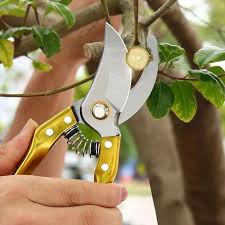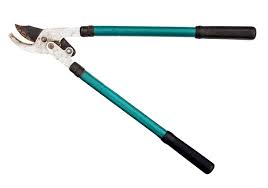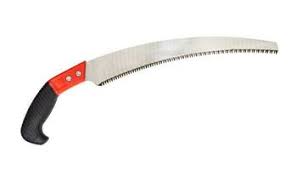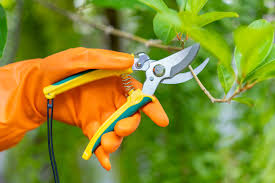Have you had a moment when you looked at your citrus tree and thought it was looking sad or not producing the amount of juicy fruit you’d hoped for, or appeared more like a mess rather than a gorgeous, productive plant? It’s not just you! A lot of gardeners who live in various areas of the USA and beyond are finding the art of trimming citrus trees difficult.
But the good news is that with the right information and a few basic methods, you can effortlessly cut your citrus trees to ensure greater health and a huge harvest without accidentally dropping them into the big orchards in the sky!
This guide will take you through 7 easy ways how to cut your citrus trees as an experienced professional. Together We will cover everything from when the ideal time to get your shears is to the most typical mistakes to avoid. Make sure you are ready to make sure that your lemon, orange, or lime tree gets all the love it deserves!
- 1. Why Trimming Citrus Trees Matter:
- 2. When to Trim Citrus Trees (Timing Really Matters)
- 3. Tools You’ll Need Before You Start (Keep Them Sharp and Clean!)
- 4. Step-by-Step Guide: How to Trim Citrus Trees (Without Damaging Them)
- 5. Special Tips for Pruning Different Citrus Types (Adapt to Your Tree!)
- 6. Fixing Overgrown or Neglected Citrus Trees (Patience is Key!).
- 7. How Pruning Boosts Fruit and Tree Health (The Sweet Rewards!)
- 8. Common Pruning Mistakes to Avoid (Learn from Others!)
- The summary:
- Frequently Asked Questions:
1. Why Trimming Citrus Trees Matter:
Remember that the pruning process is giving your tree a check-up and a bit of stimulation. So, you know why pruning is so crucial:
- Increase Fruit Production: Getting rid of unproductive or overcrowded branches redirects the tree’s energies toward growing fresh, healthy fruit.
- Improved airflow and sunlight: An open canopy lets more airflow help dry out the leaves and lower the likelihood of fungal infections, which are prevalent in humid climates. The sun’s light is essential to ensure fruit ripening and overall tree strength.
- Better Harvesting: A well-designed tree is easier to reach and pick delicious citrus.
- Pest and Disease Control: Eliminating dead or diseased trees eliminates the possibility of providing refuge for pests and diseases.
- A stronger tree structure: Getting rid of weak or cross-branch branches can encourage the creation of a solid, healthy frame that can accommodate a large fruit load.
- Common Newbie mistakes to avoid: A lot of beginners are afraid to prune too much or are worried about cutting in the wrong place at the wrong time. We’ll address these issues and provide you with the confidence to cut correctly.

2. When to Trim Citrus Trees (Timing Really Matters)
When should you actually prune your citrus tree? That’s the first big question most people have — and it’s a good one.
Let’s keep it simple:
The Best Time of Year to Prune Citrus Trees:
The ideal time to trim citrus trees is usually late winter to early spring, right before the new growth kicks in.
That’s when:
- The tree is coming out of dormancy (aka it’s waking up)
- It hasn’t started blooming yet.
- There’s no risk of Frost in most places.
Trimming during this time gives the tree a fresh start. It can put energy into new healthy growth and fruit, rather than wasting energy on dead or crowded branches.
Avoid Pruning After Frost:
If you live in an area where winters get frosty, don’t prune right after a freeze. Frost-damaged branches might look dead, but they could bounce back. Give the tree a few weeks to recover before you go in with the Clippers.
Don’t Trim While It’s Blooming:
If your tree is already flowering, hold off. Pruning during the bloom season can reduce the number of fruits you’ll get later. The tree’s energy is currently focused on producing flowers and fruit, so pruning at this time can disrupt this process and lead to a lower yield. Let the tree do its thing first.
☀️ What About Summer or Fall?
You can do some light trimming in summer if branches are overgrown or blocking sunlight. Light trimming includes removing small, dead branches or thinning out dense areas to allow more light to reach the inner parts of the tree. But avoid heavy pruning — it can stress the tree in hot weather.
Fall pruning? Not the best idea. New cuts can encourage fresh growth that gets zapped by winter chills. Pruning in fall can stimulate new growth, which is more susceptible to frost damage. It’s better to wait until spring rolls around again.
✅ Quick Summary: When to Trim:
| Season | Should You Trim? | Why or Why Not |
|---|---|---|
| Late Winter / Early Spring | ✅ Yes! | Best time to shape and refresh your tree |
| After Frost | ❌ No | Let damaged branches recover first |
| During Blooming | ❌ No | You’ll lose fruit production |
| Summer | ⚠️ Maybe | Only light shaping, no heavy cuts |
| Fall | ❌ No | Can lead to frost-damaged new growth |
3. Tools You’ll Need Before You Start (Keep Them Sharp and Clean!)
Having the right tools makes pruning easier, safer, and less stressful for your tree.
- Sharp hand shears (pruners:) are essential for cutting cleanly in shorter branches (up to 1/8 inch diameter). Make sure they are sharp to ensure an uncluttered cut that heals quickly.
- Loppers: for branches with more thickness (typically 1/2 inch or 1 1/2 inches in size). Long handles offer leverage.
- Pruning Saw: For bigger branches (over 1 1/2 inches in diameter). Pick a saw with sharp teeth specifically designed for pruning.
- Gloves: To shield the hands against thorns as well as scratches.
- Disinfectant: Rub alcohol on your hands or diluted bleach solution (1 part bleach to 9 parts of water) to clean the pruning tools prior to and after every use. This stops the spread of a variety of illnesses between trees and branches.
- Optional but Recommended:
- Safety glasses are essential for pruning taller trees because debris may fall.
- Small stool or ladder: for reaching branches higher without danger.








4. Step-by-Step Guide: How to Trim Citrus Trees (Without Damaging Them)
Now for the hands-on part! Follow these steps carefully for successful pruning:
- Step 1: Start with the “Three Ds” – Dead, Damaged, and Diseased Branches: These are your priorities. Cut these branches back to healthy wood. For diseased branches, make sure to disinfect your tools immediately after the cut to avoid spreading the issue. When cutting, always cut just above a healthy bud or another branch, avoiding leaving stubs. Crucially, when removing a branch entirely, cut just outside the branch collar. In this slightly swollen area, the branch meets the trunk or a larger limb. Do not mistake cutting flush with the trunk, as this can hinder healing.
- 2: Cut Suckers from the Base: Suckers are shoots that grow from below the graft union (the swollen area near the base of the trunk). These draw energy away from the productive parts of the tree and won’t produce the desired fruit. Prune them off cleanly at their point of origin.
- 3: Remove Water Sprouts (Those Fast-Growing Upright Shoots): Water sprouts are vigorous, upright shoots that grow from the main branches. They often grow densely and don’t typically produce fruit. Remove them unless you need a specific sprout to fill a gap in the canopy.
- 4: Thin Out Crowded Areas for Airflow and Light: Look for branches that are crossing, rubbing against each other, or growing too closely together. Remove weaker or less desirable branches to open up the canopy. Focus on making thinning cuts, which remove the entire branch back to its point of origin. Thin cutting encourages better airflow and light penetration. While heading cuts (shortening a branch) can be used for shaping, excessive heading can lead to dense, unproductive growth.
- 5: Shape the Tree – Aim for an Open, Manageable Canopy (Not Too Tall): The ideal citrus tree shape is somewhat open in the center, allowing sunlight to reach the interior. Avoid letting the tree grow too tall, making harvesting difficult. You can gradually reduce the height by pruning back the tallest branches to a lower, outward-facing bud or branch.
- 6: Cut Branches Growing Inward or Downward: Branches which are grown towards the centre of the tree can restrict airflow and sunlight. Downward-growing branches often don’t receive enough light and may become weak. Remove these to encourage outward and upward growth.
- 7: Clean Up Your Cuts and Tools Afterwards: Ensure all pruning debris is removed from around the base of the tree to prevent potential pest or disease issues. Disinfect your pruning tools one last time before storing them. For larger branches (over approximately 1 inch in diameter), consider using the “three-cut system” to prevent bark tearing:
- Cut the underside of the branch a few inches away from the trunk, going about halfway through.
- Make a second cut from the top, a couple of inches further out from the first cut. The branch will break away, preventing tearing.
- The final work is to make a clean cut just outside the branch collar.
5. Special Tips for Pruning Different Citrus Types (Adapt to Your Tree!)
Although the general rules apply, there are some subtleties to specific varieties of citrus:
- Lemon Trees: They are often vigorous growthers and especially Meyer lemons. They might require frequent, light trimming throughout the entire year in order to control their growth and promote continuous fruiting. Meyer lemons usually produce fruit on newly-planted wood.
- Lime Trees: Like the lemon tree, these are rather bushy and gain from regular pruning to maintain an open and spacious structure.
- Orange Trees: They generally require less pruning than limes or lemons. The focus should be on eliminating deadwood, suckers and branches that cross.
- Dwarf Citrus Trees: Require less pruning overall. Concentrate on keeping their shape and eliminating dead or crossed branches. Make sure not to prune too heavily.
- Citrus Trees within pots or containers: Pruning is a way to ensure that the size of the tree is manageable for the container, and also encourages healthy growth both above and beneath the ground. You may need to trim the roots once every couple of years when you report.
- Take into consideration the growth habits of the specific variety of citrus when making pruning choices.

6. Fixing Overgrown or Neglected Citrus Trees (Patience is Key!).
If your citrus tree hasn’t been pruned for a long time Do not try to do it all in one go. Pruning too often can be a shock to the tree.
- Cut Gradually over The Time: Plan pruning overgrown trees in two to three years.
- First year: Focus on removing the most obvious dead, damaged and decayed wood. The densest parts of the wood should be trimmed to allow for a better flow of air and allow for light. It is also possible with the overall form.
- Later Years: Continue shaping the tree and remove any problematic branches.
- Eliminate Dead Weight First: Prioritize removing large dead branches because they are a threat and do not contribute to the health of the tree.
- Try Drop-Crotch Pruning in order to reduce height: Instead of “topping” the tree (making random cuts on top), make use of drop-crotch pruning. Drop-crotch is the process of cutting a tree’s tall branches back to a stronger, less-growing lateral branch that is at a minimum one-third of the size of the branch to be removed. This will encourage the growth of a more natural and healthy.
7. How Pruning Boosts Fruit and Tree Health (The Sweet Rewards!)
Pruning that is consistent and accurate leads to substantial advantages:
- Improves airflow and Sunlight Permeation: This decreases the likelihood of fungal diseases prevalent in our climate. It also makes sure that all areas of the tree get the sunlight that is essential to maximize photosynthesis and the development of fruit.
- Reduces the spread of diseases and pests: An open canopy makes it less suitable for pests to hide and diseases to flourish. Eliminating infected branches stops the spread.
- Promotes Stronger Branches and larger fruit: By directing the tree’s energy, pruning can help to build a strong structure that can support a substantial fruit load, which results in bigger and healthier fruits. Also, it encourages the development of new fruiting wood.
- Realistic Results From Regular Trimming: You’ll notice an improvement in overall vigor, health and production of the fruit of your citrus trees when you do the regular trimming.
8. Common Pruning Mistakes to Avoid (Learn from Others!)
Steer clear of these common errors:
- Over-Pruning: The point to be notice avoid over-pruning becasue this, can stress the tree, reduce fruit production, and lead to excessive plant growth. Remember, it’s better to prune sparingly and frequently than to risk the health of your tree by taking too much off at once.
- Pruning At the Right Time: As discussed, the timing of pruning is of utmost importance. Be responsible and avoid excessive pruning during flowering or extreme temperatures.
- Tools that aren’t infected : This is a significant way of spreading diseases across your garden and tree. Make sure to sterilize the pruning tools you use.
- Not recognizing the need to shape the Tree in the Right Way: While removing problem branches is crucial, consider how the tree’s structure will overall shape to ensure long-term health and efficiency.
- “Topping” the Tree: Avoid making indiscriminate cuts across the upper part of the tree to lower the height. This can result in the growth of a weak, dense regrowth that may reduce the life span of the tree. Use drop-crotch pruning instead.
- Tattooing or tarring wounds: Contrary to old beliefs, sealing pruning wounds with either tar or paint is typically not recommended. It can hold in moisture, thereby increasing decay. Healthy trees heal by themselves.
- The two terms are often confused: Maybe you are confused about these words: Trimming and Pruning. While frequently used as a synonym, pruning usually refers to more substantial cuts to ensure structural health and shape, while trimming may involve less shaping or the removal of small growth. Pruning your plant is all about the long-term health and structure of the tree, and on the other hand, trimming is more about maintaining the tree’s appearance. Both are crucial.
By picking these simple steps and avoiding common mistakes, you can prune your orange trees like a professional. Congratulations on your successful pruning!

The summary:
Picking the art of pruning may seem like doing something difficult initially, but after adopting these “7 Easy Steps,” you now have enough knowledge to help transform your trees. Be aware that consistent, careful pruning will be a blessing to your trees of citrus. It’s the way to help them achieve their full potential and produce an increase in the quality of growth, a healthier and vibrant appearance and, perhaps most important, a bounty of the delicious, juicy fruit you’ve always wanted to taste. Get your sharp pruning shears, go out and enjoy the rewarding task of assisting your citrus trees grow. Happy gardening!
Frequently Asked Questions:
Q1: What is the best fertilizer for citrus trees?
The best fertilizer for citrus trees is one that’s balanced and citrus-specific. Look for something labeled “citrus tree fertilizer” or one with an NPK ratio like 6-4-6 or 8-3-9. These numbers stand for nitrogen (N), phosphorus (P), and potassium (K)—and citrus trees love these nutrients in that balance.
You can also use slow-release citrus fertilizers that feed the tree over time or go organic with compost, worm castings, or fish emulsion. Organic options are great if you are trying to keep things natural and build healthy soil.
Pro tip: Fertilize 3 to 4 times a year, starting in early spring and stopping by late summer or early fall.
Q2: How often should I use Epsom salt on a lemon tree?
Epsom salt is awesome for lemon trees—but don’t overdo it! Consider one tablespoon of Epsom salt per gallon of clean water and apply it to the soil one time in a month during the growing season (spring through summer).
Epsom salt gives your lemon tree a magnesium boost, which helps with leaf health, fruit development, and overall greening. If your tree’s leaves look yellow with green veins, that’s a magnesium deficiency—Epsom salt can help fix that.
Make sure not to use it too often or in large amounts, though, or you could harm the roots.
Q3: Why are the leaves on my citrus tree turning yellow?
Yellow leaves on citrus trees usually mean one of three things:
- Lack of nutrients – Most often magnesium (hello, Epsom salt!) or nitrogen. Use a good citrus fertilizer to fix that.
- Overwatering or poor drainage – Citrus hates soggy roots. Make sure your soil drains well and you are not watering too often.
- Cold weather – Sudden chills or frost can shock the tree and cause leaf yellowing.
Fixing yellow citrus leaves starts with checking your watering schedule, then feeding your tree with a balanced citrus fertilizer, and finally watching for temperature drops.
Q4: What is the best organic fertilizer for citrus trees?
The best organic fertilizer for citrus trees includes options like:
- Composted manure
- Worm castings
- Fish emulsion
- Blood meal
- Citrus-specific organic blends
These organic fertilizers release nutrients slowly and help build healthy, living soil. They are especially good if you are into natural gardening or want to avoid synthetic chemicals.
Apply organic fertilizer in early spring, then again in mid-summer. Always follow the package directions, and water the fertilizer in a well so nutrients reach the roots.

